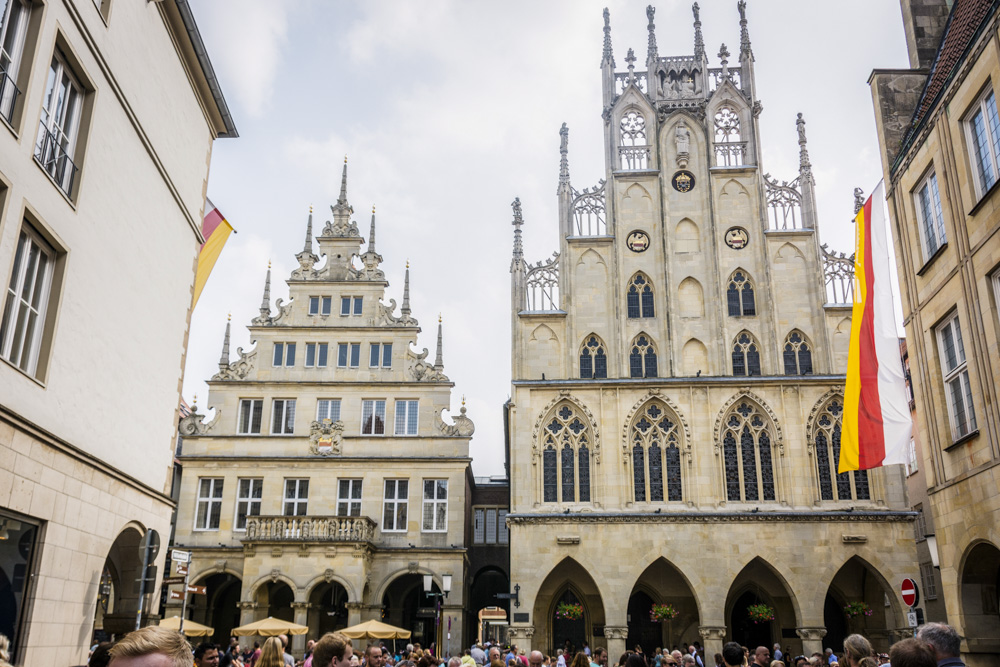Our stay in Münster was especially enjoyable since we had some German hosts for the weekend! I briefly mentioned that the previous weekend we had met a nice German lady named Annette on a train... and it turned out she had traveled to the U.S. through our very program 28 years earlier! She was generous enough to let us stay with her family for the weekend.
But first, we had to get there. This turned out to be much more challenging that anticipated. As I rode towards the main train station at 6:30 that morning, my tram driver stopped in the middle of the route and announced it was time for him to join the train driver strike. Train driver strike?! I had no idea this was coming, but once I checked my German news app, I found that train drivers were striking from 6 to 9 am that very morning. That's convenient. I frantically found a subway route (subway drivers weren't striking, only their above-ground brethren were campaigning for a wage increase) to the main train station and met my friends there, only to find our train to Münster was delayed by no fewer than 186 minutes thanks to the strike. After thinking on our feet and desperately searching for any train that was leaving Cologne in the general direction of Münster, we actually managed to escape just 40 minutes later than we originally planned.
But Münster was worth the trouble! It had a small town charm, but it was also historical and had plenty going on.
 |
| Right by the city center is a lake called the Aasee |
 |
| The Prinzipalmarkt is the focal point of Münster's historical city center |
 |
| Germans love a good market. This one was the real deal, taking up the entire main square in front of the cathedral |
 |
| Lunch was colorful. It featured, unsurprisingly, lots of potatoes |
 |
| Münster Cathedral |
 |
| The Überwasserkirche was finished by 1340 and features a huge gothic church spire |
 |
| Town Hall again |
 |
| I was pretty excited. IR majors don't get to geek out in everyday life very much |
 |
| The lady's slipper dates to the 1600s, but no one knows why it's there. More interesting is the wooden casket with a real hand, which was severed from an executed person in the 1500s |
 |
| As I said, it's a bike-centric city. We rented bikes of our own for the day |
 |
| Despite the ugly history associated with the cages outside, the interior is pretty |
 |
| Erbdrostenhof Palace, built in the Baroque style in the 1700s (and rebuilt after the war) |
 |
| Schloss Münster was built in 1803 and, of course, rebuilt after the WWII bombings |
 |
| Gardens behind the palace |
 |
| Encircling the city is the Promenade. Where the ring of trees and bike path are now once stood the city walls |
 |
| Biking around the lake brought us away from historical structures |
 |
| ...as well as to nice scenes like this |
We were then treated to an awesome dinner and nice company at Annette's house. We slept there, and the next day her generosity was on display again as she and her husband, with their two daughters in tow, took us around to look at some of the neat castles in the surrounding area.
 |
| Burg Vischering is a moated castle typical of the area. It was build in 1271 |
 |
| Schloss Nordkirchen is a moated palace sometimes called the "Versailles of Westphalia." The Baroque building was completed in 1724 and now serves as a school |
 |
| Teaching German kids to take selfies like it's my job |
We returned to Annette's home for some afternoon coffee and cake (a typical German custom, especially on the weekend), after which we were once again given dinner by our awesome hosts.
That was it for that action-packed weekend! Thanks so much to Annette and Andreas for having us. Experiencing a city is so much better when you have a German family playing host for you.


























